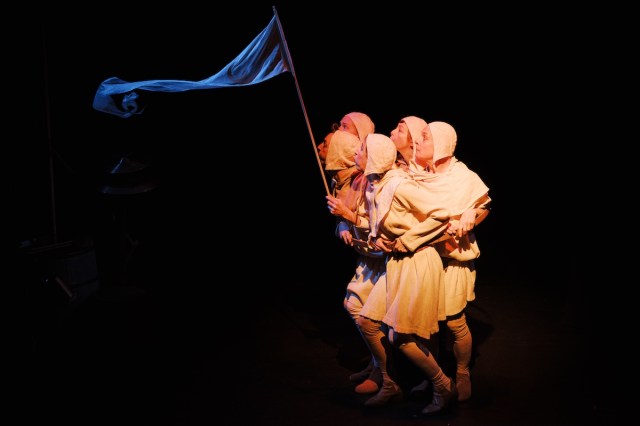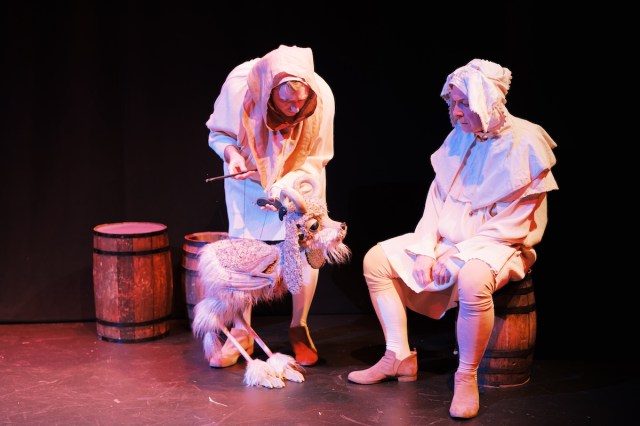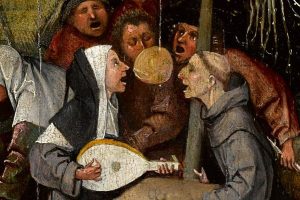Review: Adrift Describes Both a Hieronymus Bosch Painting and Our Brains During This Play
Happenstance Theater returns to New York like a troupe of wandering players.

(© Leah Huete)
The preshow music for Happenstance Theater’s Adrift, now at 59E59, is what you might hear waiting in line for turkey legs at the New York Renaissance Faire. A cardboard cutout medieval pennant flaps in the wind under another cutout of an owl in a tree. These opening set pieces and the name of the show come from this painting by Hieronymus Bosch, which serves as the basis for the first scene, in which the entire cast bobs around in a barrel, overcrowded and directionless. Happenstance turns this into an allegory about climate change, which is something of a stretch, but represents the clearest choice in this mostly rudderless exploration of medieval themes.
We later encounter two diviners (Sabrina Mandell and Alex Vernon) who answer audience questions about the future (this bit is not nearly as funny as it is meant to be). Hildegard von Bingen (Gwen Grastorf and her ethereal voice) leads the audience in song. A magician (Vernon) performs some ho-hum magic tricks. An adorable demon (Sarah Olmsted Thomas) clings onto a fool (Mark Jaster). A doctor (Grastorf) performs some highly dubious medical procedures (a lobotomy marks the darkest turn in the play). And a crone (Mandell) arrives to collect all our troubles and magic them away.

(© Leah Huete)
The company approaches this material with gentle good humor (emphasis on gentle rather than humor) and a dancer’s attention to form and the specific image. Mandell and Jaster co-direct a spartan production that spotlights the performers, although like a real troupe of wandering players, they share responsibility for the design. The puppets (by Mandell, Thomas, and Vernon) constitute the most lavish element, although Mandell’s costumes evoke medieval times on a budget. Music directors Grastorf and Jaster underscore much of the show with period-appropriate live music. It is possible to simultaneously appreciate the craft involved while recognizing its failure to capture one’s imagination.
My issue with Adrift, as it was with Happenstance’s Barococo, is that these well-selected images and finely honed performances never coalesce into a compelling whole. Each segment exists on its own, with no connective tissue beyond a vaguely shared time period. (Compare this to Jordan E. Cooper’s Ain’t No Mo’, which was similarly composed of sketches, but revolved around a hypothetical mass migration to Africa.) Some viewers will be thrilled by this freeform exploration of aesthetics, but it is not nearly as opulent and fantastical as the story-free Psychic Self Defense, which did keep me enthralled. With Adrift, I was bored and ready for it to end long before its 75 minutes had passed.
“Don’t forget to play,” one character says to another on her death bed. It’s an admirable sentiment that too many theater companies have forgotten. Happenstance should be lauded for never losing its sense of play. Now, if only they could shape it into something that won’t leave our minds the second we exit the theater.









